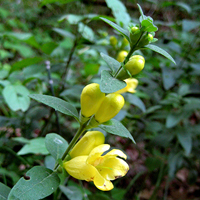Downy Yellow False Foxglove
Scientific name: Aureolaria virginica

Photo credit: Wasyl Bakowsky
Status
Endangered
“Endangered” means the species lives in the wild in Ontario but is facing imminent extinction or extirpation.
Date added to the Species at Risk in Ontario List
January 26, 2022
Read the assessment report (PDF)
What it looks like
Downy Yellow False Foxglove is a tall, herbaceous perennial with showy yellow flowers, that can reach a height of 2.5 m. The stems and leaves of this plant are covered by fine downy hairs. This plant is hemi-parasitic, meaning that it secures some of its water and nutrients by tapping into the roots of other plants, particularly oak species (Quercus spp).
Where it lives
Downy Yellow False Foxglove is found in dry, open to semi-open, upland oak forests, woodlands and savanna habitats on well-drained soils. The full range of Downy Yellow False Foxglove beyond southern Ontario covers most of the Eastern United States extending from Michigan to New Hampshire in the north and from Texas and Florida in the south.
Where it’s been found in Ontario
There are five subpopulations of Downy Yellow False Foxglove remaining in Ontario, located in:
- Waterloo
- Halton
- Hamilton
- Norfolk
- Brant
Two additional subpopulations may persist in Waterloo. Another five subpopulations are believed to be extirpated, including two in Niagara.
What threatens it
Downy Yellow False Foxglove faces threats due to its association with open to semi-open oak ecosystems. Oak ecosystems across eastern North America are in decline for a variety of reasons. Fire suppression and invasive species are threats because they result in shading, altered ground cover and competition from other species. There is also moderate to severe damage to plants due to browsing by White-tailed Deer and the possible expansion of formal trail networks causing increased foot traffic from people could pose a risk to this plant species.
Action we are taking
Endangered species and their habitat is protected under Ontario’s Endangered Species Act, 2007.
What you can do
Report a sighting
Submit your observations of species at risk to the Natural Heritage Information Centre (NHIC), which is Ontario’s conservation data centre. Join the “(NHIC) Rare Species of Ontario” project in iNaturalist to make submitting your observations quick and easy.
Volunteer
Volunteer with species at risk programs, such as community science surveys, through your local nature club, a provincial park or other conservation organizations.
Be a good steward
- Individuals, communities and organizations across the province who undertake stewardship or research activities that benefit species at risk and their habitats may be eligible to receive funding through the Species at Risk Stewardship Program (SARSP). The SARSP was created to encourage people to get involved in protecting and recovering species at risk in Ontario through stewardship actions.
- Invasive species seriously threaten many of Ontario’s species at risk. To learn what you can do to help reduce the threat of invasive species, visit:
Report illegal activity
Report any illegal activity related to species at risk to
Quick facts
- All Yellow False Foxglove species are hemi-parasites where they take some of their water and nutrients by tapping into the roots of other plants, particularly oak species (Quercus spp). This behaviour provides them with a competitive advantage on drought-prone soils.
- Mature plants flower from early July through late August.
- This species has no long-distance dispersal mechanism, which means it is difficult for it to establish naturally in new areas.